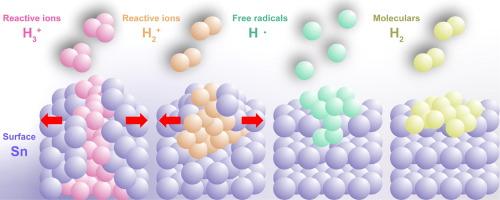Atomistic insights on hydrogen plasma treatment for Sn surfaces by first-principles calculations
IF 6.9
2区 材料科学
Q2 CHEMISTRY, PHYSICAL
引用次数: 0
Abstract
Extreme ultraviolet (EUV) lithography is essential for semiconductor manufacturing to create intricate patterns on silicon wafers by employing a light generated by laser irradiation of Sn droplets. Hydrogen radical etching is a promising way to clean the Sn debris on collector mirrors, but the underlying mechanism remains unclear. First-principles calculations were used to investigate the effects of various hydrogen species within Sn surfaces. The sub-surface reactive hydrogen ions (H2+ and H3+) significantly expanded the Sn surface areas, and they diminished the structural order because of electron transfer from Sn atoms to the reactive hydrogen ions. In contrast, the sub-surface hydrogen radicals (H·) and molecular hydrogen (H2) induced minor structural changes, while the passivation of the Sn surfaces by hydrogen radicals strengthened the surface structure. The calculated average adsorption energies for sub-surface H3+ ions closely matched the experimentally observed threshold ion energy for Sn-etching, and H2+ ions required less energy to destabilize the Sn surface structures than H3+ ions did. The simulation results are consistent with previous experimental observations of a low Sn-etching rate in radicals-only systems and support recent experimental studies emphasizing the importance of reactive ion etching in enhancing Sn-etching rates.


氢原子等离子体处理锡表面的第一性原理计算
极紫外(EUV)光刻技术是利用激光照射锡液滴产生的光在硅片上产生复杂图案的半导体制造所必需的。氢自由基蚀刻是一种很有前途的清除集热镜上锡碎片的方法,但其潜在的机制尚不清楚。用第一性原理计算研究了锡表面不同种类氢的影响。亚表面反应性氢离子(H2+和H3+)显著扩大了Sn的表面积,并由于电子从Sn原子转移到反应性氢离子而降低了Sn的结构秩序。相比之下,亚表面氢自由基(H·)和分子氢(H2)引起了轻微的结构变化,而氢自由基对Sn表面的钝化强化了表面结构。计算得到的亚表面H3+离子的平均吸附能与实验观察到的Sn蚀刻阈值离子能非常接近,H2+离子破坏Sn表面结构所需的能量比H3+离子少。模拟结果与先前在纯自由基体系中低sn蚀刻速率的实验观察结果一致,并支持最近强调反应离子蚀刻在提高sn蚀刻速率中的重要性的实验研究。
本文章由计算机程序翻译,如有差异,请以英文原文为准。
求助全文
约1分钟内获得全文
求助全文
来源期刊

Applied Surface Science
工程技术-材料科学:膜
CiteScore
12.50
自引率
7.50%
发文量
3393
审稿时长
67 days
期刊介绍:
Applied Surface Science covers topics contributing to a better understanding of surfaces, interfaces, nanostructures and their applications. The journal is concerned with scientific research on the atomic and molecular level of material properties determined with specific surface analytical techniques and/or computational methods, as well as the processing of such structures.
 求助内容:
求助内容: 应助结果提醒方式:
应助结果提醒方式:


